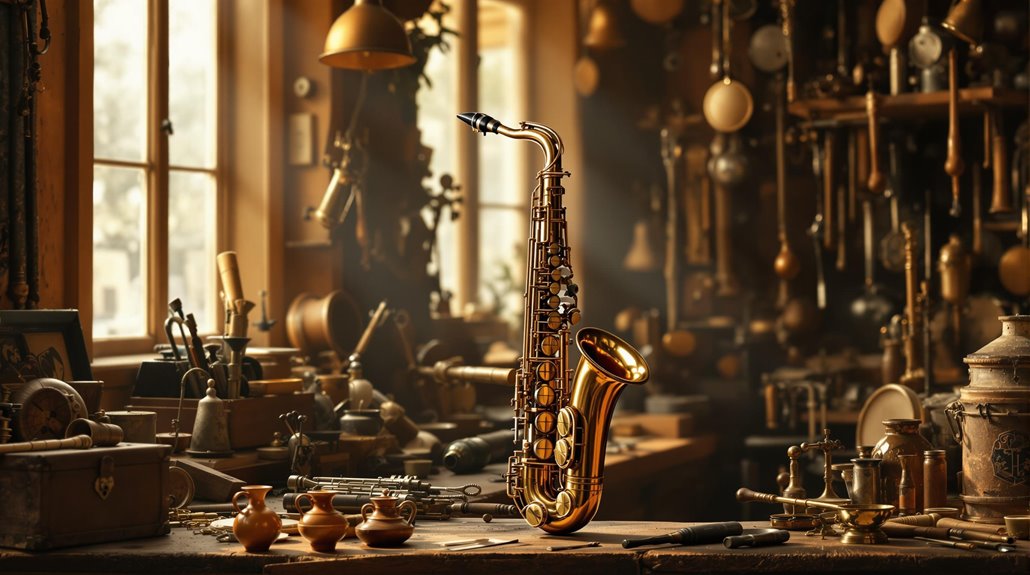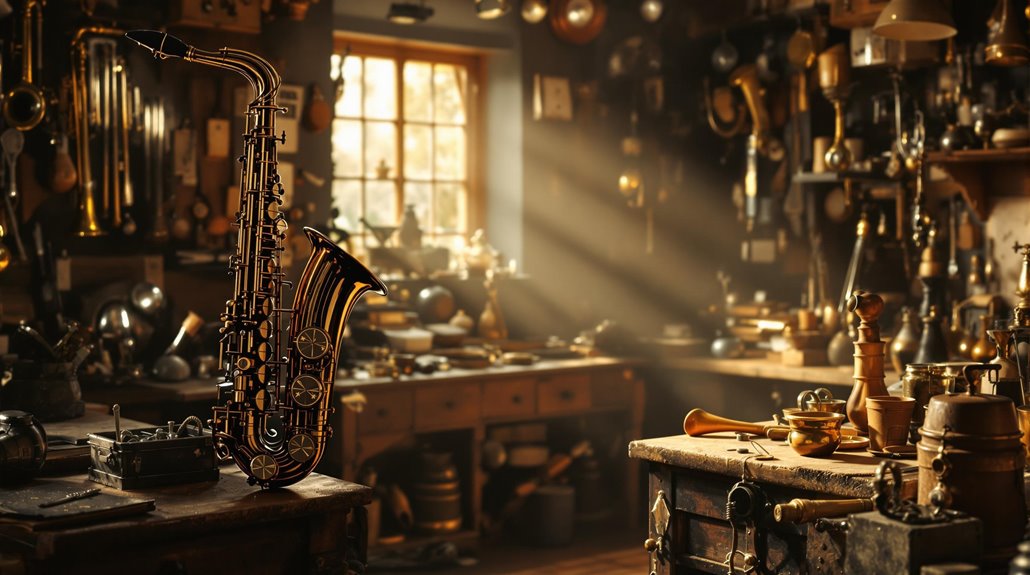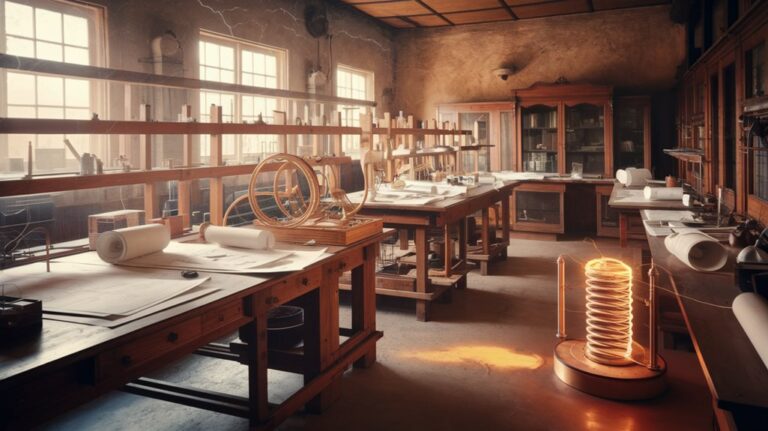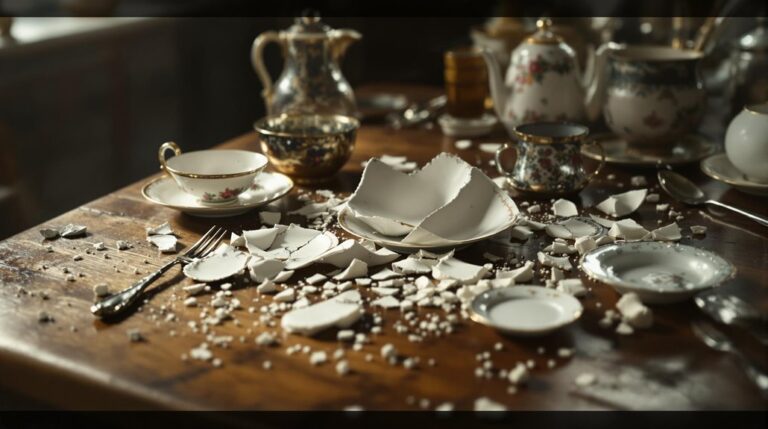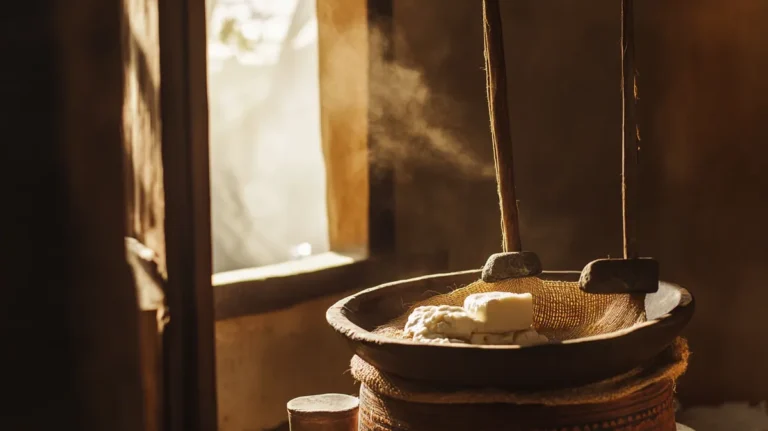Adolphe Sax: The Calamity-Filled Life of an Inventor
You've likely stumbled across peculiar musical instruments before, but the story behind the saxophone will raise your eyebrows. The Belgian inventor Adolphe Sax had more than his fair share of unfortunate encounters with mortality before creating this revolutionary instrument. His life reads like a dark comedy, punctuated by falls, explosions, and poisonings – yet these brushes with disaster shaped the resilient spirit that would transform the world of music forever. Let's explore how calamity bred creativity.
The Nine Lives of Little Sax: Surviving a Perilous Childhood
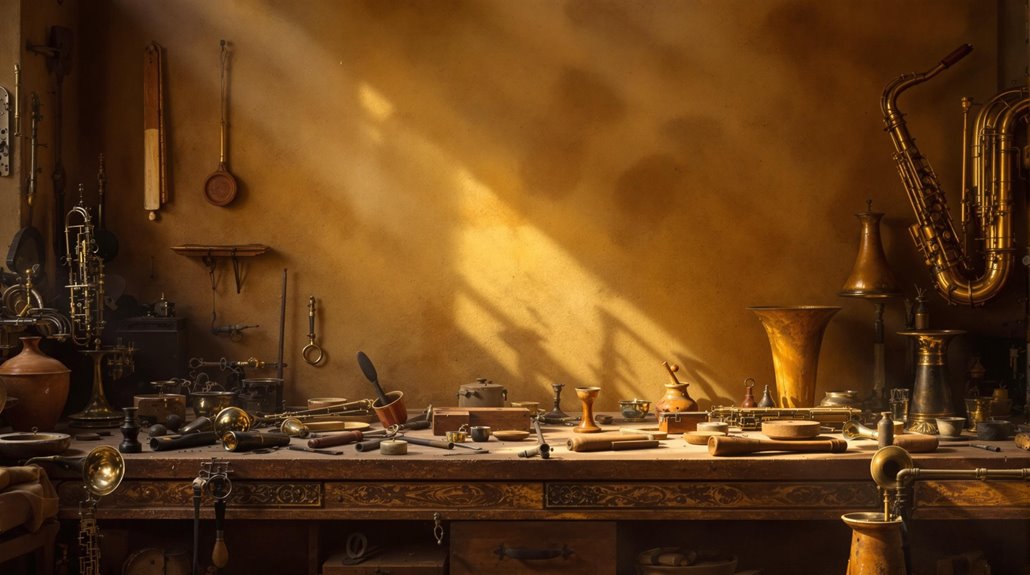
While many children experience their share of scrapes and bruises, young Adolphe Sax's childhood reads like a series of death-defying stunts.
You'll find it hard to believe that one child could survive falling from a third-floor window, drinking acid, and being caught in a gunpowder explosion. His childhood resilience was put to the test repeatedly as he faced multiple poisonings, near-drownings, and chemical exposure in his father's workshop.
Local neighbors nicknamed him "little Sax, the ghost" due to his remarkable near death survival record. Even his own mother believed he was cursed by misfortune.
Yet, despite at least seven brushes with death – including swallowing a pin, severe burns from a hot frying pan, and toxic fume exposure – young Sax persevered, turning his turbulent childhood into fuel for future innovation. Growing up in his father's workshop, where musical instruments were made, helped shape his destiny as an inventor despite his misfortunes. Born in Dinant, Belgium, his early life of misfortune would eventually give way to remarkable achievement.
A Musical Prodigy in His Father's Workshop
Born into a family of instrument makers in 1814 Dinant, Belgium, young Adolphe Sax couldn't have asked for a better musical foundation.
Under his parents' musical mentorship, he learned the craft in their workshop, where they produced everything from wind instruments to harps. His father's work as a skilled carpenter laid the groundwork for Adolphe's future innovations. His hometown's rich history in brass manufacturing only enhanced his creative environment.
You'll find his talent emerged remarkably early. By age 14, he'd crafted his first clarinet, and his early inventions were turning heads at Europe's industrial exhibitions.
His musical education wasn't just practical – he studied flute, clarinet, voice, and composition at the Brussels Conservatory. By 24, he'd patented an improved bass clarinet design and created nine new instruments for the 1840 Belgian Exhibition.
His prodigy status was so remarkable that judges hesitated to award him first place. His neighbors dubbed him the ghost-child from Dinant due to his numerous near-death accidents and misfortunes during childhood.
The Birth of the Saxophone: A Revolutionary Design
During the early 1840s, Adolphe Sax revolutionized the musical world by creating an instrument that would bear his name. His saxophone evolution combined the power of brass with the expressiveness of woodwinds, featuring a groundbreaking parabolic bore and single-reed mouthpiece. His instrument emerged as a novel musical tool that transformed the landscape of instrumentation.
The revolutionary features of Sax's design included identical fingering for both registers and the ability to overblow at the octave, making it more intuitive to play than the clarinet.
You'll find his original patent included 14 different versions, from sopranino to contrabass, though the E♭ and B♭ series became standard. By the time he secured his Belgium patent in 1850, he'd expanded the instrument's range and refined its mechanics.
Despite opposition from traditional musicians, the saxophone's popularity soared, with 20,000 instruments sold between 1843 and 1860. After demonstrating his remarkable talent for instrument design, Sax was appointed to a teaching position at the Paris Conservatoire in 1857.
Beyond the Saxophone: Sax's Other Musical Innovations
Although the saxophone remains Adolphe Sax's most celebrated creation, his innovative spirit produced numerous other groundbreaking instruments throughout his career.
The Saxhorn legacy stands as his earliest patented success, introducing a family of six valved brass instruments that revolutionized orchestral arrangements and influenced modern brass bands. His impressive workshop in Paris produced up to 20,000 instruments during his career there. Military bands readily embraced his inventions, establishing a strong foundation for their use.
You'll find Sax's innovative timeline fascinating:
- 1843: Patented the Saxhorn family, which shaped the development of flugelhorns and euphoniums
- 1845: Introduced the Saxotromba history with seven narrow-bore instruments bridging traditional brass and saxhorns
- 1849: Created the Saxtuba for military bands, though it never achieved widespread use
Beyond brass instruments, you'd be amazed to learn that Sax improved the bass clarinet design at just 24 and conceptualized ambitious projects like the Saxocannon and Saxotonnerre, though these remained unrealized.
Legal Battles and Financial Struggles
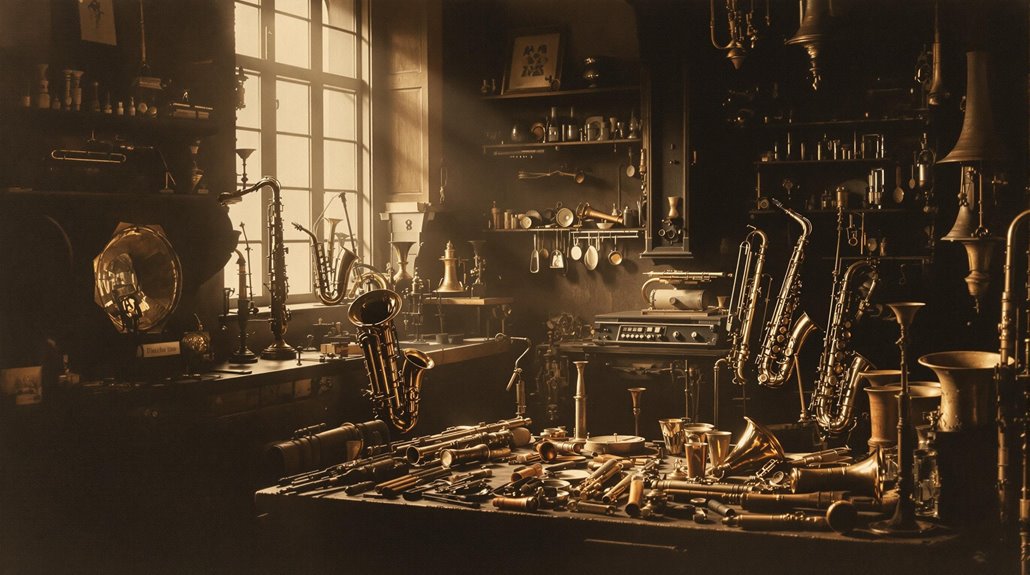
Despite his remarkable inventions, Sax's life became mired in legal battles that would plague him for over two decades.
His rivals, including the ruthless United Association of Instrument Makers, orchestrated a campaign of sabotage that reportedly included arson and attempted murder.
You'll find that his rivals, united as the Association of Instrument Makers, challenged his patent applications and even produced counterfeit saxophones to discredit him.
Though Sax initially secured a profitable French government contract in 1845, the Revolution of 1848 stripped him of these military agreements.
The endless patent disputes and political turmoil drove him to financial ruin. He declared bankruptcy three times – in 1852, 1873, and 1877.
You can imagine his despair when he was forced to sell his entire personal instrument collection and couldn't even afford the entry fee for the 1878 Paris International Exposition.
When his patent expired in 1865, competitors were finally free to manufacture saxophones without legal repercussions.
Sax died in poverty in 1894, his legacy overshadowed by decades of courtroom battles.
The Bittersweet Symphony: Sax's Enduring Impact on Music
Time has painted a different picture of Sax's legacy than the one he witnessed in his final days. The saxophone evolution he pioneered would transform music far beyond his imagination, bridging the gap between woodwind and brass instruments while offering unprecedented versatility in sound and expression.
The saxophone's ability to produce both powerful and soft tones made it a revolutionary musical innovation. The cultural significance of Sax's inventions emerged in three distinct waves:
- Military bands adopted his instruments, particularly saxhorns, revolutionizing martial music.
- Working-class musicians gained access to high-quality instruments, democratizing music-making.
- Jazz musicians embraced the saxophone's expressive qualities, making it an iconic symbol of the genre.
You'll find Sax's influence everywhere in modern music, from classical orchestras to rock bands. The Met's Celebrating Sax exhibition showcases twenty-six remarkable instruments that demonstrate his family's innovative spirit.

